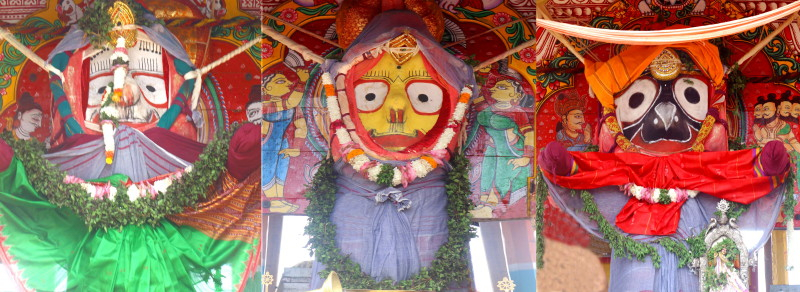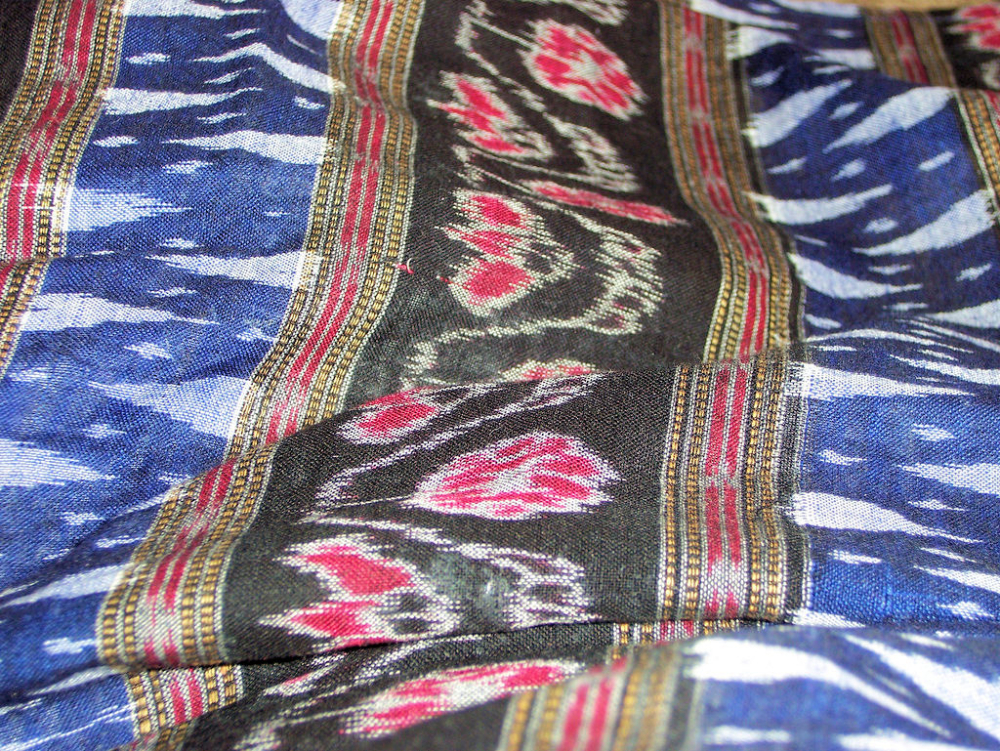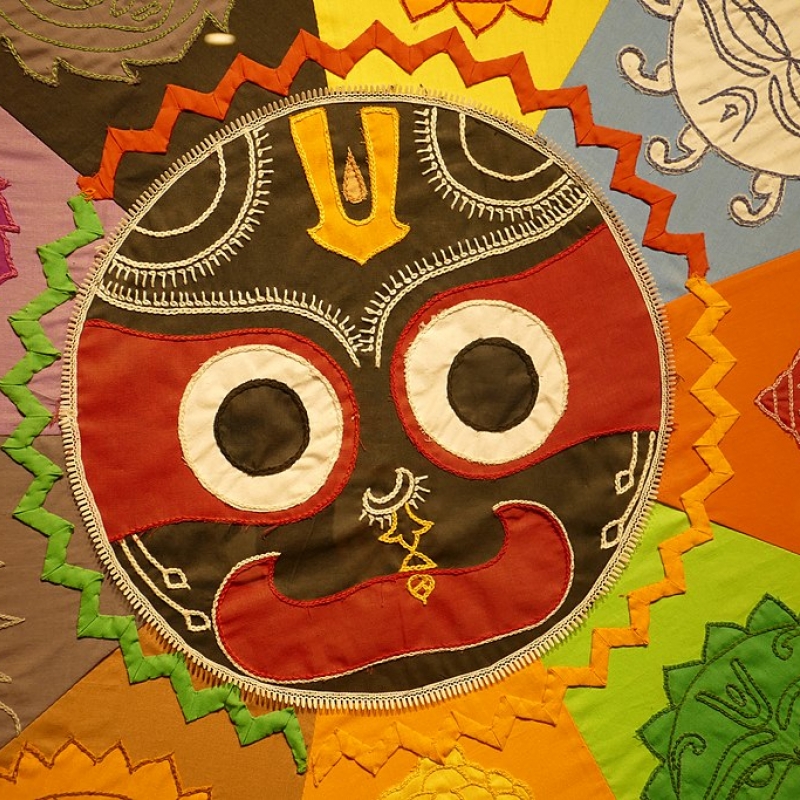A search for new clothes for Lord Jagannath during navakalevara—a ceremony of periodic renewal (every 12 years) of the wooden images in Puri’s Jagannath temple—unravels the business in sacred textiles. Prof. B.N. Goswamy writes about what goes into such a search and its trial. (Photo courtesy: Wikimedia Commons)
This article appeared originally in The Tribune, Chandigarh under the title ‘Textiles for Lord Jagannath’, and is reproduced here with permission.
There couldn’t be many who have never heard of Puri, that great centre of pilgrimage in Orissa, or of its presiding deity, Jagannath, “Lord of the World”, who rules over the hearts and life of millions in that region. But it is more than likely that few, at least in our part of the country, know much about the ‘life’ and the periodic ‘demise’ of the Lord.
The Oriyas know it all, of course, and noisy, impassioned multitudes of them celebrate each event as it unfolds. But even for them, there is nothing quite like the navakalevar, “the taking on of a new body” by the Lord—by the sacred Triad in fact—every 12 years.
Also see | Art N Soul: The ‘Timeless’ Indian Shawl
The elaborate details of this complex, esoteric ceremony—the announcement of the impending decay of the Lord’s body, the preparations for renewing it, the setting up of search parties for locating the appropriate tree for fashioning the new images from, the jubilation at finding it, the sacralizing rituals and the escorting of it back to Puri, the embedding of the essence of the old image, the brahmapadartha, inside it, and so on—are all a part of nearly everyone’s awareness there.

Everyone becomes part of it: the upper echelons of management, the priests attached to the temple, the large body of sewaks each of whom has performed a specific service for as long as memory goes back, the vast numbers of devotees who wait eagerly for every detail that emanates from the inside of the shrine. There is excitement in the air.
I had occasion to be led into the very heart of all this activity from an altogether different angle, however, when I was in Ahmedabad recently. I was talking to a colleague, B.C. Mohanty, the highly respected scholar from Bhubaneswar, together with whom I serve on the Board responsible for managing the great Calico Museum of Textiles. Mr Mohanty is a textiles person, once known as the ‘tussur king’ of Orissa and author of a distinguished body of work on subjects like natural dyes, ikat fabrics, special weaves, bagru prints, etc. When, in the course of our conversation, the subject of navakalevara at Puri came up, he turned rather naturally to textiles, and the role they play in the ceremonies centering upon the event.
Related | The Sambalpuri Ikat of Odisha: History, Symbolism and Contemporary Trends
One knows that textiles form a substantive part of the sacred “wooden” images, for layer upon exquisite layer of them are wrapped around the inner core of wood. I also knew from my earlier reading that, before the enterprise of locating the appropriate tree—the dare—is embarked upon, each of the designated priests and sewaks receives from the temple management a piece of textile: a silken sari for the three chiefs among the Daitas, a two-metre piece each for the other Daitas, a full length of turban-silk for the temple Mahapatra as the images emerge from the sanctum. But what I did not know about—till Mr Mohanty told me—was the prodigious quantities of silk and cotton textiles that are needed by the temple for other purposes. For distribution among the vast number of sewaks and their wives, for one.

When the deities “pass away”, Mr Mohanty told me, and the old images are put away under the earth, a shraddha ceremony is performed, much like in ordinary, devout Hindu households. And then the Brahmins have to be given customary offerings, among which are, rather naturally, saris for the women and dhotis for men. For years together, Mr Mohanty reminisced, the task of producing these vast silk lengths was given to one master weaver, attached to the temple, who it seemed, was not going about his work too honestly.
Tired of the high prices being charged and the poor quality being supplied, the temple manager once approached Mr Mohanty, in the days that he was Director of Textiles, asking him to help with procuring the needed quantity of good, honest silk. The cloth had to be specially woven, as per ritual specifications, and time was a constraint. But Mr Mohanty took the challenge up: with the required quantities of yarn that he was able to manage, he approached the weavers. Only to find that the master weaver/contractor, suddenly fearful of his monopoly being broken, had spread the word around that if any weaver took the job up for anyone other than him, his entire family would be cursed by the Lord, and destroyed.
Also see | Velvet Weaving: History and Technique
It was a tough call, but Mr Mohanty ultimately triumphed. Personally, he remembers, he travelled from village to village, gathering the weavers in groups, and simply saying to them: “Do you really believe that this is how Jagannath would ever repay anyone who works towards serving him?” Sense prevailed, and all the required quantity of silk was produced. In time, and at a much lower cost than before.
But, speaking of those who work for profit, like this contractor, is anything sacred at all?
Profane and Vulgar
That nothing is sacred, when it comes to profits, came to me in a curious way the other day. While changing channels on my TV set, I chanced upon a snippet of a video-jockey, with his obligatory, equally callow, female companion, sitting dressed up as a Hindu deity and his consort, golden crowns and all. The usual mindless natter was going on. Suddenly, in the midst of it, the young man uttered in grave tones, but as if to himself, “Narayan! Narayan!”, in the approved fashion of the sage Narada in so many of our films. And then, after the briefest of pauses, shouted aloud, as to a servant: “Arre Narayan! Kahan mar gaya tu?”, or something to this effect. Is this funny? No, it isn’t. It is crass and vulgar. Also the fact that a TV channel is able to get away with idiocies like this, is crass and vulgar.
This article has been republished as part of an ongoing series Art N Soul from The Tribune.













